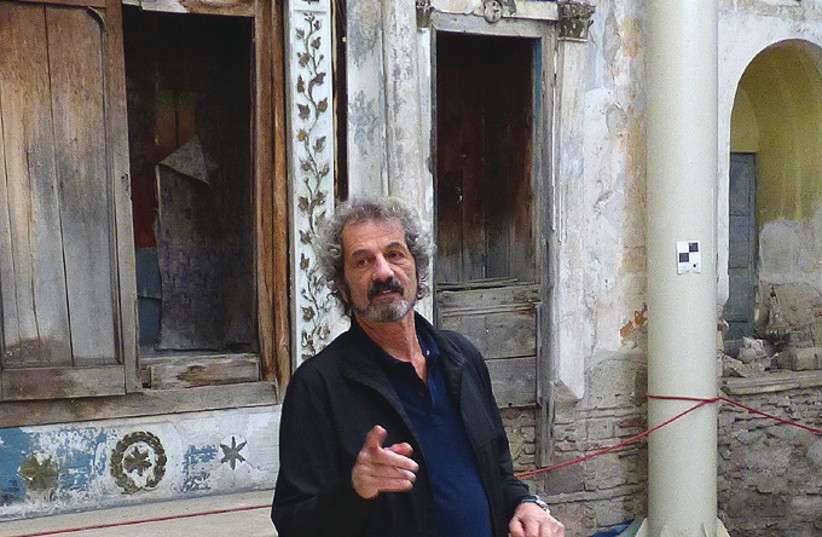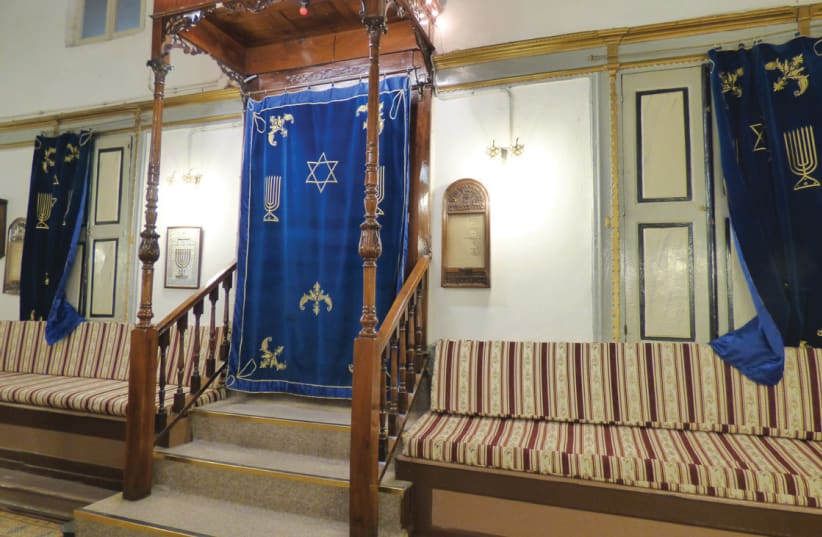While the Jewish community in Izmir is now only a shadow of its once vibrant self, the Izmir Jewish Heritage Project is bent on changing that reality. At its head is Nesim Bencoya, representing the existing Izmir Jewish Community Foundation and the Izmir Jewish Community at large.
On a bright and beautiful fall morning, Bencoya met a small press group of Jewish Heritage writers and took us to the top level of a soon-to-be demolished parking garage for a city planning development. There we had an overview of the old port of Izmir and what was left of the jumbled Jewish Quarter, while he enthusiastically described his vision to us.
The Izmir Jewish Heritage Project is undertaking a monumental restoration and rehabilitation of five of the nine still-standing synagogues, returning the buildings to their former glory and joining them into one big museum compound. The fact that they are so close together makes it possible to link them, allowing each of the restored buildings to serve a different function as part of the overall museum.
The Etz Hayim, Talmud Tora and Senyora Synagogues will feature culture and art performances and exhibits, while Bet Hillel will serve as a memorial house for Rabbi Hayim Palacci. Algazi Shalom and Bikur Holim Synagogue will be open for religious services and celebrating weddings, bar mitzvahs, etc., and Portekiz Synagogue will function as a conference center.
We visited the five old shuls in varying stages of restoration. Restoring them to their original state is a daunting undertaking. Working from old drawings, bits of surviving paint and archeological investigations, and with the help of architects and artists, one by one the buildings are slowly coming back to life. It helps that they all share common layout features, i.e. the Tevah (Bimah) placement, which is located in the center of the main prayer hall.


Another feature of the Izmir synagogues is that the Echal has three doors, the main one for the Torah scrolls in the center and a cupboard on either side that was most likely used as storage for books. The purpose of the design of three is lost to history but probably traces back to the synagogues of Spain, which they were trying to emulate.
Jews migrated to the Byzantium Empire and settled around Istanbul, Smyrna (present-day Izmir), Bursa and Sardis as early as the destruction of the Temple in Jerusalem in 555 BCE, but it was not until the Spanish expulsion of the Sephardim in 1492, that the area played host to multitudes of Jews fleeing conversion or death.
Impoverished by the confiscation of their properties and goods, imposed as a condition of escaping the Holy Inquisition, communities of destitute Sephardic Jews clustered together along the Smyrna coastline. Turkish tribes had long-ago established settlements on the rise of the hill known as “Kadifekale” so the newcomers settled at the bottom, closer to the Aegean Sea. With such a large influx, the massively crowded Jewish Quarter extended all the way to the sea. Other minority groups followed and after the Jewish quarter became the Armenian section, then the Greek and finally the European – mostly Italian – all in self-imposed segregated settlements.
Iberian Jews rebuilt their lives
SLOWLY, THE Iberian Jews rebuilt their lives and fortunes and began constructing synagogues reminiscent of the lifestyle they had left behind. For protection, they built their synagogues close together in a warren of alleyways navigable only by the greater community of Jews, which at its peak is estimated was about 30,000 Orthodox Sephardic Jews, clustered into the crowded area.
By the late 18th century, as the Jewish population prospered, they began moving out of the congested seaside communities to the greener, less crowded, mountainside city of Karatas and by 1860, the final synagogue, Bet Israel, was built in that upscale neighborhood. Karatas is a district split between two levels; there is the bottom level fronting the narrow coastline and a level facing the steep hills above. Bet Israel was built at the lower level, while many of the Jewish families lived on the upper level, necessitating a daunting climb.
Initially, a 155-step ladder was put in place to navigate from one level to another. In order to help the community, a wealthy philanthropist named Nesim Levi Bayraklıoglu, built a state-of-the-art elevator in 1907, that would whisk women, children and the elderly up from the shul to their homes in the heights.
Nesim Levi was a humble, illiterate merchant who accumulated a great fortune in banking and trading and wanted to give back to the community that supported him on his rise. He also donated one of his mansions to be turned into the Karatas Jewish Hospital and arranged for the income generated from the small fee charged to ride the Elevator to help finance the Hospital’s upkeep. Today, the elevator is a big tourist attraction, with restaurants and shops leading up the street toward the ride.
Bencoya’s mission is to bring together the three major Abrahamic religions, Jews, Christians and Muslims, through understanding each other’s customs and to help develop an appreciation of how similar we all are. His aim is to open a dialogue first in Izmir and then the world. The museum will be a bridge to connect the community with the general population and a way to fight antisemitism through education and commonality. The project has the financial backing of the European Union, Turkish Authorities and foreign funds, along with community support.
Although the majority of the Jewish population was Sephardic, Ashkenazi Jews began arriving in Izmir following the pogroms in Russia at the end of the 19th century. Nevertheless, of the surviving synagogues on Synagogues Street, all of them are of Sephardic heritage and they all held services in a combination of Hebrew and Ladino.
The museum will display a collection of some 2,000 holy books from the 16th and 17th centuries and a rare textile collection of parochet (Holy Ark curtains), Torah covers and binder covers, along with other artifacts conserved from the community.
When work is completed on the two remaining synagogues, Hevra and Forasteros, scheduled for July 2023, the compound will function as the Izmir Jewish Heritage Visit Center. Currently, it is open to locals and tourists alike for artistic activities related to Jewish Culture, including the Sephardi Cultural Festival, which was held over Hanukkah.
Bencoya put together a documentary which can be viewed at https://www.youtube.com/watch?v=ccS_N_Koiok&t=383s
He has also established a fund with the help of the American Sephardi Federation. Here is the direct link for donations: https://mailchi.mp/asf/izmir.
